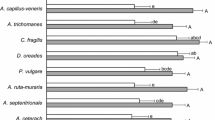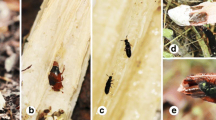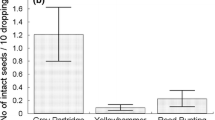Abstract
Endozoochory plays a prominent role for the dispersal of seed plants, and dispersal vectors are well known. However, for taxa such as ferns and bryophytes, endozoochory has only been suggested anecdotally but never tested in controlled experiments. We fed fertile leaflets of three ferns and capsules of four bryophyte species to three slug species. We found that, overall, spores germinated from slug feces in 57.3 % of all 89 fern and in 51.3 % of all 117 bryophyte samples, showing that the spores survived gut passage of slugs. Moreover, the number of samples within which spores successfully germinated did not differ among plant species but varied strongly among slug species. This opens new ecological perspectives suggesting that fern and bryophyte endozoochory by gastropods is a so-far-overlooked mode of dispersal, which might increase local population sizes of these taxa by spore deposition on suitable substrates.


Similar content being viewed by others
References
Arosa ML, Ramos JA, Quintanilla D, Brown LG (2010) First report of fern (Culcita macrocarpa) spore consumption by a small mammal (Apodemus sylvaticus). Mammal Biol 75:115–121
Beattie AJ, Culver DC (1982) Inhumation—how ants and other invertebrates help seeds. Nature 297:627
Boch S, Prati D, Werth S, Rüetschi J, Fischer M (2011) Lichen endozoochory by snails. PLoS One 6(4):e18770
Bråthen KA, González VT, Iversen M, Killengreen S, Ravolainen VT, Ims RA, Yoccoz NG (2007) Endozoochory varies with ecological scale and context. Ecography 30:308–320
Charrier M, Brune A (2003) The gut microenvironment of helicid snails (Gastropoda: pulmonata): in situ profiles of pH, oxygen, and hydrogen determined by microsensors. Can J Zool 81:928–935
Davidson AJ (1989) The consumption of selected moss species by slugs in the family arionidae. Dissertation, University of Reading, Reading
Davidson AJ, Harborne JB, Longton RE (1990) The acceptability of mosses as food for generalist herbivores, slugs in the Arionidae. Bot J Linn Soc 104:99–113
Duthie C, Gibbs G, Burns KC (2006) Seed Dispersal by Weta. Science 311:1575
Frahm J-P, Frey W (2004) Moosflora, 4th edn. Eugen Ulmer, Stuttgart
Fröberg L, Björn LO, Baur A, Baur B (2001) Viability of lichen photobionts after passing through the digestive tract of a land snail. Lichenologist 33:543–550
Gittenberger E, Groenenberg DSJ, Kokshoorn B, Preece RC (2006) Biogeography: molecular trails from hitch-hiking snails. Nature 439:409
Glime JM (2007) Bryophyte Ecology, Vol 2. Bryological interaction. Ebook sponsored by Michigan Technological University and the International Association of Bryologists, [WWW document] URL http://www.bryoecol.mtu.edu/. Accessed 20 January 2012
Kimmerer RW, Young CC (1995) The role of slugs in dispersal of the asexual propagules of Dicranum flagellare. Bryologist 98:149–153
Kreft H, Jetz W, Mutke J, Barthlott W (2010) Contrasting environmental and regional effects on global pteridophyte and seed plant diversity. Ecography 33:408–419
McVeigh I (1937) Vegetative reproduction of the fern sporophyte. Bot Rev 3:457–497
Nebel M, Philippi G, Quinger B, Rösch M, Schiefer J, Sebald O, Seybold S, Voggesberger M (1993) Die Farn- und Blütenpflanzen Baden-Württembergs. Band 1: Allgemeiner Teil, Spezieller Teil (Pteridophyta, Spermatophyta) Lycopodiaceae bis Plumbaginaceae, 2nd edn. Eugen Ulmer, Stuttgart
Parsons JG, Cairns A, Johnson CN, Robson SKA, Shilton LA, Westcott DA (2007) Bryophyte dispersal by flying foxes: a novel discovery. Oecologia 152:112–114
Porley R, Hodgetts N (2005) Mosses and liverworts. Collins, London
Proctor VW (1961) Dispersal of Riella spores by waterfowl. Bryologist 64:58–61
R Development Core Team (2011) R: a language and environment for statistical computing. R Foundation for Statistical Computing, Vienna
Raghavan V (1989) Developmental biology of fern gametophytes. Cambridge University Press, Cambridge
Rees WJ (1965) The aerial dispersal of mollusca. Proc Malacol Soc Lond 36:269–282
Schupp EW, Jordano P, Gómez JM (2010) Seed dispersal effectiveness revisited: a conceptual review. New Phytol 188:333–353
Speiser B (2001) Food and feeding behaviour. In: Barker GM (ed) The biology of terrestrial mollusks. CABI, Wallingford, pp 259–288
Türke M, Heinze E, Andreas K, Svendsen SM, Gossner MM, Weisser WW (2010) Seed consumption and dispersal in ant-dispersed plants by slugs. Oecologia 163:681–693
Türke M, Andreas K, Gossner MM, Kowalski E, Lange M, Boch S, Socher SA, Müller J, Prati D, Fischer M, Meyhöfer R, Weisser WW (2012) Are gastropods, rather than ants, important dispersers of seeds of myrmecochorous forest herbs? Am Nat 179:124–131
Turner H, Kuiper JGJ, Thew N, Bernasconi R, Rüetschi J, Wüthrich M, Gosteli M (1998) Fauna Helvetica 2: Atlas der mollusken der schweiz und liechtensteins. CSCF, Neuchâtel
van Tooren BF, During HJ (1988) Viable plant diaspores in the guts of earthworms. Acta Bot Neerl 37:181–185
Wada S, Kawakami K, Chiba S (2011) Snails can survive passage through a bird’s digestive system. J Biogeogr 39:69–73
Acknowledgments
We thank A. Bergamini for the identification of Bryum pallescens, S. Braybrook, K. Esfeld, and T. Imhof for assistance in the laboratory, A. Gygax for preparing Fig. 1, and E. Allan for revising the English.
Author information
Authors and Affiliations
Corresponding author
Additional information
Communicated by Andreas Prinzing.
Rights and permissions
About this article
Cite this article
Boch, S., Berlinger, M., Fischer, M. et al. Fern and bryophyte endozoochory by slugs. Oecologia 172, 817–822 (2013). https://doi.org/10.1007/s00442-012-2536-0
Received:
Accepted:
Published:
Issue Date:
DOI: https://doi.org/10.1007/s00442-012-2536-0




